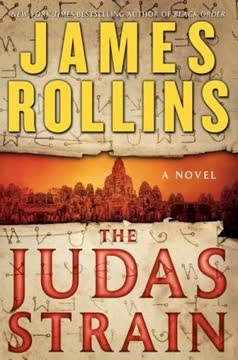Plot Summary
Marco's Forbidden Journey
In 1293, Marco Polo and his family, returning from China, are forced to torch their fleet and crew on a remote Sumatran island after a mysterious, virulent plague devastates them. The survivors, including a Mongol princess, are sworn to silence about what they found: a city of the dead, where a strange pestilence has wiped out all life. Marco's father insists the secret must die with them, but Marco preserves a forbidden map in code, hinting at a cure and a curse. The trauma and guilt of this journey will echo through centuries, as the true nature of the plague and its connection to the world's future remain hidden, waiting to resurface.
The Milky Sea Awakens
Modern-day marine biologist Susan Tunis investigates a mass dolphin beaching in the Indian Ocean, only to discover a glowing "milky sea" of bioluminescent bacteria. The phenomenon quickly turns lethal, killing sea life and infecting Susan herself. The horror escalates as the bacteria begin to attack human hosts, causing flesh-eating symptoms. Susan's infection marks the beginning of a new pandemic, one that echoes the ancient plague Marco Polo encountered. The sea's unnatural glow is both a warning and a harbinger, as the world stands on the brink of a biological disaster that science cannot yet explain.
Venetian Shadows and Betrayals
In Venice, a museum curator is hunted for stealing a nondescript Egyptian obelisk, which, under ultraviolet light, reveals a code in a language predating hieroglyphs. The obelisk is coveted by the shadowy Guild, a global organization seeking to weaponize ancient secrets. The curator's murder and the obelisk's theft set off a chain reaction, drawing in Sigma Force and their enemies. The obelisk's code, tied to Marco Polo's forbidden journey, becomes the key to both the origin and the cure of the coming plague. Trust is scarce, and betrayal is everywhere, as the past and present collide in a deadly race.
Sigma Force Mobilizes
Sigma Force, a covert team of "killer scientists," is drawn into the crisis as the pandemic spreads. Commander Gray Pierce, haunted by his father's Alzheimer's and family tensions, is thrust into the heart of the mystery when the assassin Seichan crashes into his life, wounded and desperate. As Sigma's director Painter Crowe juggles bureaucratic obstacles and personal stakes, the team must navigate a web of global conspiracies, ancient codes, and personal betrayals. The stakes become personal for Gray as his parents are targeted, and the line between ally and enemy blurs.
Outbreak on Christmas Island
Christmas Island is transformed into a nightmare as a toxic bloom kills sea life and infects the human population. Sigma operatives Monk and Lisa, embedded with the World Health Organization, witness the rapid evolution of the disease: benign bacteria turn into flesh-eating monsters, and the infected descend into madness and cannibalism. The Guild orchestrates a hijacking of a cruise ship, using the disaster as a laboratory for their own ends. The island's unique ecology, including its famous red crabs, holds clues to both the origin and the possible resistance to the Judas Strain.
The Guild's Deadly Game
The Guild, led by the enigmatic Dr. Devesh Patanjali, seizes control of the cruise ship, turning it into a floating laboratory and prison. Scientists and civilians are forced to participate in brutal experiments as the Guild seeks to harness the Judas Strain as a bioweapon. Lisa is forced to collaborate, while Monk leads a desperate resistance with unlikely allies, including cannibal tribes. The Guild's ruthlessness is matched only by their scientific ambition, and the line between savior and monster grows thin as the true nature of the Judas Strain is revealed.
Bloodlines and Secrets
Gray's parents are kidnapped by the Guild's assassin Nasser, forcing Gray into a deadly game of obedience and deception. Seichan's loyalties are questioned as her past with Nasser and the Guild comes to light. The search for the cure becomes a race against time, with Gray's family as collateral. The team must decipher Marco Polo's coded legacy, navigate ancient rivalries, and confront the possibility of a traitor in their midst. The cost of secrets—personal and historical—becomes painfully clear as the body count rises.
High-Seas Catastrophe
Monk, Lisa, and their allies face escalating dangers: pirate attacks, cannibal tribes, and genetically altered predatory squids in the island's lagoon. The cruise ship becomes a battleground as the infected turn on each other in a frenzy of hunger and madness. Monk orchestrates a daring escape, sacrificing himself to save Lisa and the potential cure. The survivors flee as the island's net collapses, the ship burns, and the Guild's plans unravel. The cost of survival is high, and the line between human and monster is blurred by the Judas Strain's insidious effects.
The Obelisk's Hidden Code
The obelisk's code, written in angelic script, is revealed to be a map—one that traces the path of the ancient plague and its cure. With the help of Vatican archaeologist Vigor Verona, Gray and Seichan follow Marco Polo's trail across Istanbul, Persia, and Cambodia. The code's solution requires not just intellect, but sacrifice and trust. The journey leads them to the ruins of Angkor, where the final secret is hidden beneath the Bayon temple. The past's sins and hopes are inscribed in stone, waiting to be unlocked.
The Hunt for the Cure
The team descends into the heart of Angkor, where the source of the Judas Strain is revealed: a primordial pool of cyanobacteria, guarded by ancient codes and the legacy of Friar Agreer. Susan, the first survivor, must risk everything to become the living cure, exposing herself to the pool's deadly eruption. The science of the Judas Strain is intertwined with myth, language, and the very structure of human DNA. The cure is not a drug, but a transformation—one that comes at a terrible cost.
Cannibals and Cannibals
The Judas Strain's final stage is revealed: it drives the infected into a state of insatiable hunger and psychosis, turning them into cannibals. The ancient cycle of plague and survival is mirrored in the present, as the survivors must fight not just the Guild, but the madness within. The cure, forged in fire and sacrifice, is humanity's only hope. The line between savior and monster is razor-thin, and the cost of redemption is measured in blood.
The Judas Strain Unleashed
Nasser, desperate and wounded, unleashes the full fury of the Judas Strain, collapsing the Bayon temple and threatening to release the plague on a global scale. The survivors, trapped and hunted, must use every ounce of cunning and courage to escape. The cure is finally forged, but not before the world stands on the brink of a new dark age. The ancient gateway to hell is opened and closed again, but the scars remain.
The Angelic Language
The angelic script is revealed to be more than a code—it is a genetic language, a blueprint for human potential and survival. The story explores the intersection of science and faith, the mysteries buried in our DNA, and the possibility that humanity's greatest strengths and weaknesses are written in the language of angels. The cure for the Judas Strain is not just biological, but existential—a reminder of the thin line between creation and destruction.
The City of the Dead
The ruins of Angkor, the city of the dead, become the final battleground. The survivors confront the legacy of Marco Polo, the sacrifice of Friar Agreer, and the cost of knowledge. The cure is delivered, but not without loss. The city's secrets are both a warning and a hope for the future, as the survivors reckon with the consequences of their actions and the price of survival.
The Bayon's Secret Heart
Beneath the Bayon, the survivors face their greatest challenge: the pool of the Judas Strain, the legacy of the past, and the threat of annihilation. Susan's transformation, Lisa's courage, and Gray's leadership are tested to the breaking point. The Guild's ambitions are shattered, but at a terrible cost. The heart of the mystery is revealed, and the survivors must choose between vengeance and mercy, destruction and hope.
Sacrifice and Salvation
Monk's sacrifice, Susan's transformation, and the survivors' courage bring the story to its emotional climax. The cure is delivered to the world, but not all are saved. The survivors must reckon with their losses, their choices, and the hope for a better future. The story's emotional core is laid bare, as love and sacrifice become the true antidote to the Judas Strain.
The Last Door Opens
The survivors emerge from the darkness, changed by their ordeal. Seichan's true allegiance is revealed, and Gray must decide whom to trust. The world is saved, but the scars remain. The story ends with a promise: that the fight against darkness is never over, and that hope is always possible, even in the face of betrayal and loss.
Homecoming and Farewell
The survivors return home, forever changed. Gray reconciles with his family, Lisa finds solace with Painter, and the world begins to heal. Monk's sacrifice is honored, and the story ends with a message of hope: that even in the face of unimaginable loss, life endures, and the future is unwritten.
Characters
Gray Pierce
Gray Pierce is the heart of Sigma Force—a brilliant, driven operative whose scientific mind is matched only by his sense of duty and deep-seated guilt. His relationship with his ailing father and the threat to his family force him to confront his own vulnerabilities. Gray's journey is one of trust and betrayal, as he navigates the shifting allegiances of allies and enemies alike. His leadership is tested by impossible choices, and his emotional arc is defined by sacrifice, love, and the struggle to protect those he cares about, even at great personal cost.
Seichan
Seichan is a complex, enigmatic figure—a deadly Guild assassin with a hidden agenda and a capacity for both violence and compassion. Her past with Nasser and the Guild haunts her, and her relationship with Gray is fraught with tension, attraction, and mistrust. Seichan's psychological depth lies in her struggle to define herself outside the roles imposed on her by others. Her journey is one of self-discovery, as she seeks redemption for her past actions and ultimately reveals herself as a double agent, risking everything for a chance at a new life.
Lisa Cummings
Lisa is a medical doctor and physiologist whose empathy and intellect make her both a healer and a fighter. Her relationship with Painter Crowe grounds her, but her drive to make a difference leads her into the heart of the crisis. Lisa's psychoanalysis reveals a woman torn between duty and desire, haunted by the suffering she witnesses and the choices she must make. Her courage and compassion are tested as she becomes the key to forging the cure, and her emotional journey is one of loss, hope, and the search for meaning in chaos.
Monk Kokkalis
Monk is Sigma's muscle and heart—a former Green Beret with a prosthetic hand and a deep love for his family. His humor and resilience mask a profound sense of responsibility. Monk's journey is defined by sacrifice: he risks everything to save his friends and the world, ultimately giving his life to ensure the cure's survival. His psychological depth lies in his acceptance of mortality and his unwavering loyalty, making his loss deeply felt by all who knew him.
Painter Crowe
Painter is the director of Sigma Force, balancing the demands of leadership with his personal connection to Lisa. His half-Native American heritage and stoic demeanor conceal a man deeply affected by the suffering of his team. Painter's arc is one of control and vulnerability, as he navigates bureaucratic obstacles, personal loss, and the weight of command. His relationship with Lisa humanizes him, and his decisions shape the fate of the world.
Susan Tunis
Susan is a marine biologist whose infection with the Judas Strain transforms her into the key to humanity's survival. Her journey is one of terror, transformation, and ultimate sacrifice. Susan's psychological arc is defined by her struggle to retain her humanity as she becomes something more—and less—than human. Her memories, grief, and longing for her lost husband ground her, even as she becomes the living embodiment of hope and the cure.
Vigor Verona
Vigor is a Vatican archaeologist and priest whose knowledge of history and languages is crucial to unraveling the mystery. His faith and intellect are tested as he confronts the intersection of science, myth, and the supernatural. Vigor's psychoanalysis reveals a man haunted by past failures and driven by a desire to atone. His relationship with Gray and Seichan is paternal, and his arc is one of wisdom, humility, and the search for truth.
Amen Nasser
Nasser is the Guild's chief assassin—a cold, calculating killer whose personal vendettas and ambition drive much of the story's conflict. His psychological profile is marked by trauma, cruelty, and a need for control. Nasser's relationship with Seichan is twisted by betrayal and rivalry, and his pursuit of Gray is relentless. His ultimate downfall is a product of his own hubris and inability to see beyond his own pain.
Dr. Devesh Patanjali
Devesh is the Guild's scientific mastermind, orchestrating the experiments and atrocities aboard the cruise ship. His intellect is matched only by his moral blindness, as he justifies any means for the sake of discovery. Devesh's psychological depth lies in his capacity for both brilliance and brutality, and his downfall is a result of his inability to recognize the limits of science without compassion.
Kowalski
Kowalski is Sigma's muscle—a former Navy seaman whose blunt humor and surprising insight provide levity and support. His loyalty and courage are unwavering, and his presence grounds the team in moments of crisis. Kowalski's psychological arc is one of growth, as he moves from comic relief to indispensable ally, proving that heroism comes in many forms.
Plot Devices
Dual Timelines and Historical Echoes
The narrative structure weaves together Marco Polo's thirteenth-century journey with the modern-day pandemic, using historical documents, coded relics, and secret diaries to bridge the centuries. The past's sins and secrets are mirrored in the present, as the characters race to decipher ancient codes and prevent history from repeating itself. The use of dual timelines creates a sense of inevitability and urgency, as the consequences of forgotten history threaten the future.
The Judas Strain as Catalyst
The Judas Strain is both a literal and symbolic catalyst—a virus that turns benign bacteria into killers, driving the infected into madness and cannibalism. Its scientific plausibility is grounded in real-world biology, but its effects are amplified to apocalyptic levels. The strain's ability to alter human behavior and DNA serves as a metaphor for the dangers of unchecked ambition, the fragility of civilization, and the thin line between savior and destroyer.
Codes, Maps, and Angelic Script
The story's central mystery revolves around the decoding of the obelisk's angelic script—a language that predates history and may be embedded in human DNA. The use of codes, maps, and cryptic inscriptions drives the plot, forcing the characters to rely on intellect, intuition, and trust. The angelic script serves as both a literal key to the cure and a metaphor for the hidden potential within humanity.
Foreshadowing and Symbolism
The narrative is rich with foreshadowing: the glowing sea, the cannibal city, the recurring image of the turtle and the angelic language. These symbols serve to connect the story's disparate threads, hinting at deeper truths and the interconnectedness of science, myth, and destiny. The use of foreshadowing heightens suspense and rewards attentive readers with layers of meaning.
Sacrifice and Redemption
The story's emotional core is built on sacrifice: Monk's selfless heroism, Susan's transformation, Gray's willingness to risk everything for his family. Redemption is hard-won, and the cost of survival is measured in blood and loss. The narrative structure ensures that every victory is bittersweet, and that hope is always tempered by the memory of what was lost.
Analysis
The Judas Strain is a high-octane blend of historical mystery, scientific thriller, and emotional drama, exploring the consequences of humanity's relentless pursuit of knowledge and power. At its core, the novel is a meditation on the dangers of forgetting the past, the fragility of civilization, and the potential for both destruction and redemption that lies within us all. The Judas Strain itself is a powerful metaphor for the unintended consequences of human ambition: a virus that turns friend into foe, order into chaos, and survival into a test of character. The story's use of dual timelines, coded relics, and the angelic language underscores the idea that the answers to our greatest challenges are often hidden in the places we least expect—in history, in myth, and in the very fabric of our DNA. The emotional arc of the characters, defined by sacrifice, love, and the struggle to trust, grounds the story's grand themes in personal stakes. Ultimately, The Judas Strain is a cautionary tale about the cost of secrets, the necessity of compassion, and the enduring hope that even in the face of apocalypse, humanity can find a way to heal.
Last updated:
Review Summary
The Judas Strain receives mostly positive reviews, with readers praising its blend of history, science, and action. Many enjoy the fast-paced plot involving a deadly virus, Marco Polo's journey, and global adventure. Rollins' research and ability to weave fact with fiction are highlighted. Some criticize pacing issues and far-fetched elements. The Sigma Force characters are well-developed, and readers appreciate the series' continuity. While some find it formulaic, most consider it an entertaining and engaging thriller.
Sigma Force Series
Similar Books
Download PDF
Download EPUB
.epub digital book format is ideal for reading ebooks on phones, tablets, and e-readers.















